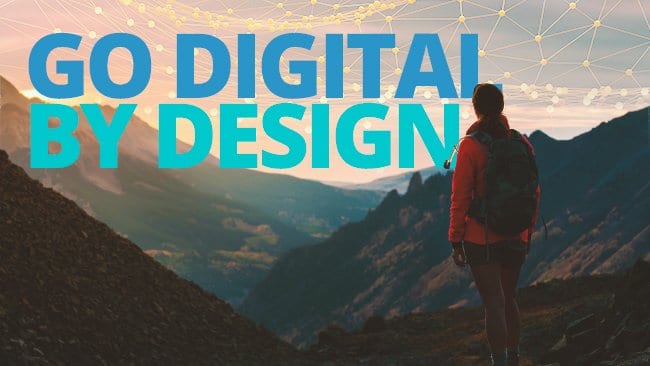
Businesses around the world are undergoing a digital transformation, using technology to radically improve performance by rethinking what customers want most and creating operating models that offer competitive differentiation.
For many companies, it’s no longer a question of whether to go digital. The question is how fast, how far, and how to make it a success.
Many experts urge companies to get started on the path to digital transformation, but few tell them how to do it. This article will explore the paths to digital transformation and provide some insights into how to do it right, with a focus on how to instill digital habits into customers. So let’s get started.
Consumers’ Digital Habits
Our daily habits and the activities we like to do regularly are an integral part of our lives. In fact, there’s a strong connection between our deeds and ourselves. As John Dryden pointed out: “We first make our habits, and then our habits make us”. So what are the digital habits of consumers today?
- Customers are always connected: Most smartphone users don`t go an hour without checking their phones. It is a life habit. We love our smartphones. Users sleep near their cell phones so as not to miss notifications.
- Customers look for immediacy: In our fast-paced world, seconds matter. From several popular websites, they will focus only on one in the end – the most convenient and the fastest. What this means is that companies have to make life easier for the customer by simplifying processes.
- Customers still cling to traditional ways of interacting with companies, while they are increasingly using digital for their social and entertainment needs.
Customer service can be enhanced significantly by digital initiatives. Companies with multiple channels to the customer have to provide an integrated experience. Multichannel services require envisioning and implementing change across customer experience and internal operational processes.
The constant flux nature of the digital landscape means that brands must adapt their marketing strategies to map the shifting consumption habits of consumers. To be present where consumers are focusing their attention, brands must be aware of the shifts in real-time.
The Digital Disconnect / The Digital Usage Paradox
Here’s the paradox: although consumers are increasingly using digital for their social and entertainment needs, they often resort to more traditional methods to interact with certain companies. For example, despite the increased spending on digital tools, like desktop automation, most consumers still prefer human contact with a call center, especially if they do not quickly find a way of solving their specific issue online. This need for human contact seems to contradict the increasing use of digital.
This is why companies need to actively foster digital habits amongst consumers, and break these consumer habits. This is crucial, as ultimately the future of customer service is non-human service. According to Gartner, by 2020, customers will manage 85% of their relationship with businesses without interacting with a human.
Paths to Digital Transformation – Digital Adoption
According to Cap Gemini, executives are digitally transforming three key areas of their enterprises: (1) customer experience, (2) operational processes, and (3) business models. And each of these three pillars has three different elements that are changing. These nine elements form a set of building blocks for digital transformation (MIT SLOAN MANAGEMENT REVIEW, January 2014).
The three major building blocks with which companies are digitally transforming customer experience are (1) in-depth customer understanding, (2) top-line growth, and (3) customer touchpoints.
Digital transformation requires strong leadership to drive change and a vision regarding which parts of the company need to be transformed.

In reality, few, if any, offerings and operations can ever be entirely digitized. Physical and digital processes need to be managed together without alienating customers and creating unnecessary levels of complexity. Integrating new and traditional operations will require evaluating the impact on customers.
Companies taking a proactive position in the digital transformation and leveraging the full potential of disruptive technologies are: Reshaping customer value propositions, remodeling their business operations to deliver new customer value propositions effectively, efficiently, and in innovative ways. Doing both at the same time leads to the broadest industry transformation.

The best path for a particular company depends on its objectives, industry context, expectations from customers, and competitive pressures. In industries where the product is mostly physical and customer requirements for information are not yet advanced, such as mining, companies may want to begin digital transformation with operations (Path 1). In others, such as financial services, where new revenue-based services can be offered online and through mobile devices, the initial focus should be on the customer value proposition (Path 2). However, many companies or industries, can redefine customer value propositions and operating models at the same time (path 3), to succeed in digital transformation. Organizations that do so become market leaders.
Actively Fostering Digital Habits
Companies cannot just assume that once they invest in digital, consumers will automatically change their habits. They need to actively foster digital habits, replacing old habits with new habits. Digital transformation can be accelerated by actively bringing digital experiences to the customer instead of waiting for the customer to come to you.
Digital habits need to be fostered throughout the consumer life cycle, at every touchpoint.
- Customer Acquisition – Digitally enabled phone agents to drive sales conversions
- Onboarding – Proactive digital onboarding tools with instant access to customer service
- Billing Inquiry – Increased digital IVR self-service and contextual billing explanations with agent access
- Customer support – Context-aware visual engagement at call centers drives resolution & productivity
- Retention and cross-sell – Proactive recommendations and intelligent agent guidance to sell through your service channels
Digital habits need to be fostered before, during, and after an interaction.
BEFORE
- Proactive Outbound Mobile Interactions
- Qualified access to Digital Channels (Virtual Assistant, Chat & Email)
- Video interactions instead of the store or branch interactions
DURING
- IVR: Just in time digital engagement (Visual IVR)
- Digital: Contact-Us Guide
- Digital: Eliminate 1800# & Skip IVR
- Store/Branch: Digital Kiosks & Mobile Engagement
AFTER
- Persistent messaging and engagement rooms instead of repeat phone calls
- Real-time digital collaboration during and after phone interactions
A Recipe for Successful Digital Transformation
The problem is that too many companies are still getting it wrong. To create engagement, many entrepreneurs end up pursuing digital strategies that engage by leading conversations and setting up customer expectations. But this doesn’t necessarily change habits. Digital engagement strategies should be doing the opposite – giving customers the tools at every touchpoint to lead the way.
Despite the current obsession with Digital Transformation, most efforts will fail.
However, we believe there are some important tips that can separate successful practitioners from the rest.
- Don’t care about “Digital Transformation” per se. Digital Transformation should not be regarded as an outcome. “Digital” is an enabler, and “Transformation” is a by-product, not the destination.
- Bring digital experiences to the customer, at every touchpoint. Accelerate DT by bringing digital experiences to the customer instead of waiting for the customer to come to you.
- Have CEOs who lead from the front and question everything. The dynamism of these leaders has a flow-on effect, which enables the rest of the organization to try things for themselves and find better ways.
- Don’t annoy customers. We are inundated with content, and our attention spans have become shorter and shorter. If you want to attract and keep customers, keep your engagement simple and ensure it adds value.
- Focus on mobile-first rather than creating a robust website that fails to deliver a good experience via mobile. You will damage your brand if you are not delivering a mobile-friendly experience. To test the mobile-readiness of your site, check out Google’s mobile-friendly test.
- Make engagement easy. Any call to action should be easy to find and complete. Whether you are asking for a form fill or selling a product, the experience should be effortless.
- Create the same experience across each device or platform. Consumers are looking for an experience that is consistent in terms of branding and information across the digital device platform.
- Better, not more functions. You will not help the sale process by building more functions into your digital platforms. Customers need better, not more, tools.
- To capture greater market share, consider how you can build more streamlined functionality – for example, fewer necessary clicks into your websites and mobile apps. That way, your customers will use your dedicated apps.
- Obsess about delivering end-user value. The end-user is the primary anchor point for all digital initiatives. Nothing is more important than maintaining an obsessive focus on adding value to their experience – it’s the end-user that defines success.
Summary
Digital transformation is occurring across organizations. Investments are being made in new technology, business models, and supporting systems and processes to change the way companies function in an increasingly digital economy.
Companies need to be able to engage with customers at the right time, with the right person, on the right channel.
Digital is becoming the dominant contact preference, and organizations are undergoing Digital Transformation initiatives to meet customer demand.
Customers expect full continuity as they channel hop, across both digital and voice channels. They expect a consistent experience across multiple touchpoints. Companies want to channel pivot expensive voice calls into more cost-effective digital channels and personalize the experience.
There are many inhibitors to Digital Transformation: Your voice and digital channels may be disconnected. Your interactions may not be cross channel ready, and you may need to provide digital collaboration to your voice callers to reduce AHT.
Uniphore is a leading provider of digital solutions that efficiently and effectively foster digital habits and promote digital adoption.
[About the author] Dylon Mills is the Director of Marketing Content Strategy & Development at Uniphore. As such, Dylon’s main responsibilities are to strategize, create, and deliver content for Uniphore’s product portfolio that aligns with the global Go-To-Market strategy, corporate positioning, and marketing campaigns. Dylon’s prior work experience includes Product Management at one of the top Fortune 500 Technology companies, Symantec Corporation. Outside of work, Dylon enjoys problem-solving and any project that includes building/tinkering with tools. Dylon holds a BS Consumer Economics from the University of Georgia.
Dylon Mills is the Director of Marketing Content Strategy & Development at Uniphore. As such, Dylon’s main responsibilities are to strategize, create, and deliver content for Uniphore’s product portfolio that aligns with the global Go-To-Market strategy, corporate positioning, and marketing campaigns. Dylon’s prior work experience includes Product Management at one of the top Fortune 500 Technology companies, Symantec Corporation. Outside of work, Dylon enjoys problem-solving and any project that includes building/tinkering with tools. Dylon holds a BS Consumer Economics from the University of Georgia.
)